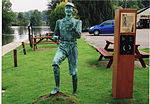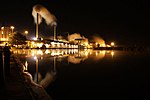Poplar Farm Meadows, Langley
Ramsar sites in EnglandSites of Special Scientific Interest in NorfolkSpecial Areas of Conservation in EnglandSpecial Protection Areas in England

Poplar Farm Meadows, Langley is a 7.5-hectare (19-acre) biological Site of Special Scientific Interest east of Loddon in Norfolk. It is part of the Broadland Ramsar site and Special Protection Area, and The Broads Special Area of Conservation.This calcareous fen on the edge of the flood plain of the River Yare is spring fed. It is managed by light summer grazing and the flora is diverse, with some uncommon species. There are also areas of tall fen and the site is crossed by dykes which have clear spring water and a variety of aquatic plants.The site is private land with no public access.
Excerpt from the Wikipedia article Poplar Farm Meadows, Langley (License: CC BY-SA 3.0, Authors, Images).Poplar Farm Meadows, Langley
Langley Street, South Norfolk Langley with Hardley
Geographical coordinates (GPS) Address Nearby Places Show on map
Geographical coordinates (GPS)
| Latitude | Longitude |
|---|---|
| N 52.565 ° | E 1.495 ° |
Address
Langley Street
Langley Street
NR14 6AD South Norfolk, Langley with Hardley
England, United Kingdom
Open on Google Maps








